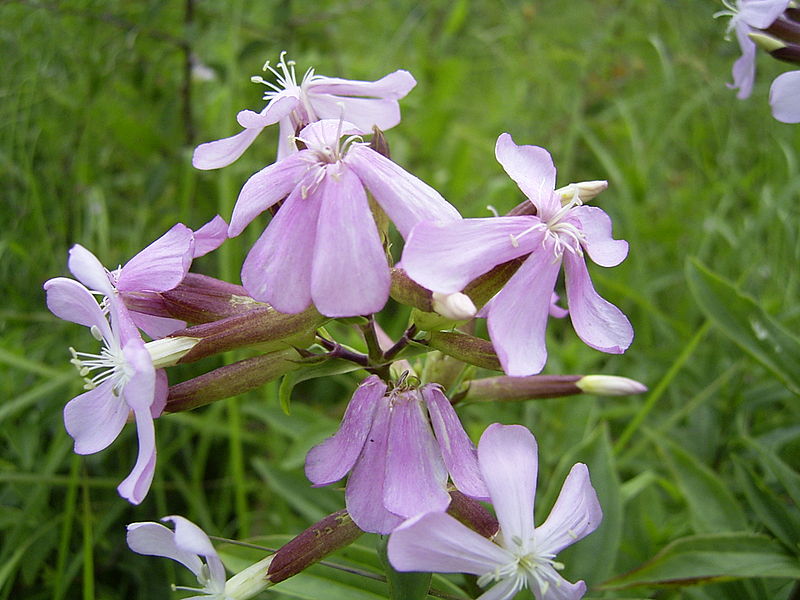 Soapwort, crow soap, soapweed, lather root, our ancestors named Saponaris officinalis for its use as a soap. All it took was a quick trip to the garden to gather some leaves which were boiled to make a liquid soap that could be used to wash people and clothing. Both the leaves and the roots contain saponin, which creates a lather when added to water. It has been used to produce the “head” on beer.
Soapwort, crow soap, soapweed, lather root, our ancestors named Saponaris officinalis for its use as a soap. All it took was a quick trip to the garden to gather some leaves which were boiled to make a liquid soap that could be used to wash people and clothing. Both the leaves and the roots contain saponin, which creates a lather when added to water. It has been used to produce the “head” on beer.
The boiled leaves and roots of the soapwort plant results in a cleanser that can remove fats and grease but is so mild that even today, museums use soapwort to clean delicate textiles.
Soapwort should not be eaten. In large quantities can induce vomiting and diarrhea. It is not harmful in small quantities and is, in fact, used in the manufacture of halvah, a Middle Eastern sweet.
Soapwort is also known by names that were descriptive of the occupations that used it. “Bouncing Bet” was a term for a washerwoman. “Fuller’s herb” described the process of washing finished woolen cloth also known as “fulling”.
Soapwort is a herbaceous perennial hardy in zones 4 through 10. It is native to the temperate zones of Europe and Asia. The European colonists brought it with them to North America where it has thrived. It likes full sun and well-drained soil. Too much moisture in the soil will send it into rapid decline. Mature plants are 2 to 2 ½ feet tall with pink or occasionally white flowers that resemble Sweet William from which another of its common names, Wild Sweet William, derives. The flowers open in the evening and are very fragrant making them an excellent addition to a Moon Garden. Bloom time is from May to September.
Soapwort can become invasive spreading by underground rhizomes. Unless you are harvesting the roots to make soap, it is recommended that you plant soapwort either in containers or use barriers around the plants to prevent the rhizomes from spreading.
Soapwort is easily grown from seed. The seed can be direct sown in your garden in the spring after the soil has warmed to at least 65°F. Press it firmly into the soil and then lightly cover it. You can expect germination in 2 to 3 weeks. Or you can start your seeds indoors 6 weeks before your last frost. Plant your seedlings outside after all danger of frost has passed. Keep the seedlings evenly moist.
Making soap with soapwort is very easy. Simply pick some leaves, bruise them or chop them and then boil for 30 minutes. Cool the liquid and strain out the leaves. The roots can also be boiled or you can dry the roots and grind them up to use like a soap powder.
Roots should be harvested in the fall. If your clump of soapwort is getting over crowded, pull up every third plant. This will give your plants some breathing space to grow and expand giving you more roots and leaves to make into soap.


12 Comments on “Soapwort”
Hello! can i make a liquid cleanser with ground soapwort powder mixed in water, with other things? will it be effective? When I look at recipes for homemade cleansers, all of them call for the boiling method… Thank you!
Soapwort needs to be boiled to bring out its soapy properties. After boiling, let the mixture cool and then add your other ingredients if you wish.
Can I keep this as a house plant
Herbs are very difficult to grow indoors. You will need to provide extra light as explained in this article: https://advicefromtheherblady.com/growing-herbs/growing-herbs-indoors/
Can it be grown from cuttings, and if yes, how? Thank you
Soapwort is usually propagated by division. Fall is the best time to divide it. It can also be done in the spring.
Hi! Is it safe to use Soapwart as dish soap in outdoor settings? I understand it contains saponin which kills fish. I am worried it might seep into the soil and find its way into water bodies. Thank you!
Yes, it is safe to use outdoors because you would be using it in small quantities. It is only when a toxin is used in large quantities by an entire town or a factory that ground water seepage would be a concern.
Can I gather and dry leaves for future, emergency soap use…. and then boil them later when needed? I keep thinking that perhaps i might need soap come winter.
Also if i do boil leaves in water, how much water, to how many leaves?
Thank you very much. Just identified soapwort in my central NJ garden. Want to use everything I find!
Gina
The leaves can only be used fresh. The roots, however, can be dried and ground up to use like a soap powder. Alas, I can’t give you a ratio of water to leaves or powdered roots because I have never actually used soapwort for soap. You will have to experiment a little.
May I ask how you sow the seeds indoors? Do you cold stratify your seeds first by chance?
Thanks!
I do not cold stratify the seeds when I start them indoors because they need warm soil to germinate.